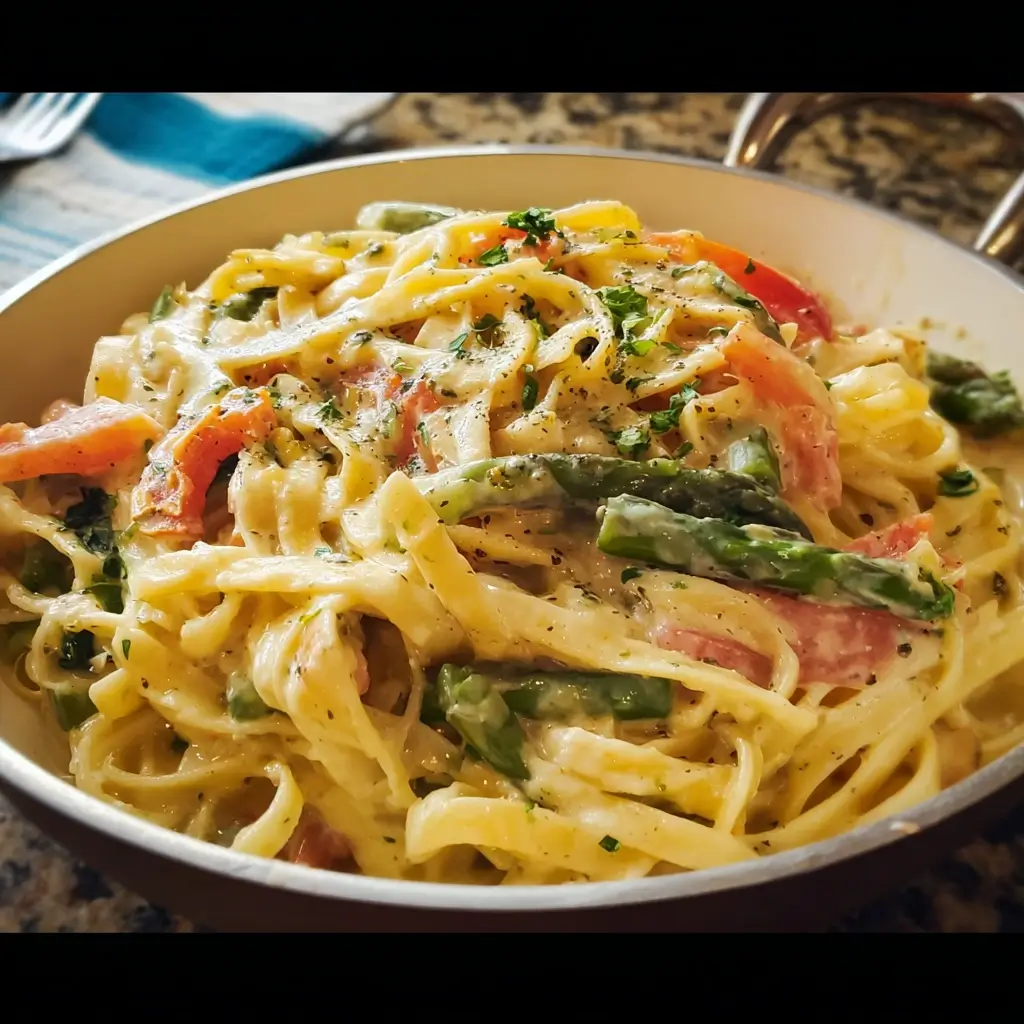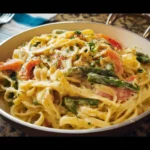Of all the dishes that grace our family table, there’s one that signals the end of a long winter and the bright, hopeful arrival of spring more than any other: Pasta Primavera. I still remember the first time I made this specific version. I was looking for a way to get my kids excited about vegetables, and the kaleidoscope of colors in this dish—the vibrant green of the asparagus and peas, the sunny yellow of the bell peppers, the deep orange of the carrots—was my secret weapon. The moment I brought the large platter to the table, their eyes lit up. My youngest, usually a staunch veggie-skeptic, pointed and asked, “Can I have the rainbow pasta?” Success! The creamy, yet light, Parmesan and lemon sauce coated every noodle and vegetable perfectly, creating a symphony of flavors that was both comforting and refreshingly bright. It has since become our go-to for everything from quick weeknight dinners to celebratory Easter lunches. It’s a dish that not only nourishes the body but truly feeds the soul, a vibrant celebration of nature’s bounty in a single, glorious bowl.
What Exactly is Pasta Primavera?
Before we dive into the cooking process, let’s talk about what makes this dish so special. “Primavera” is the Italian word for “spring,” and that’s precisely what this recipe embodies: a celebration of fresh, seasonal spring vegetables. Interestingly, while its name is Italian, Pasta Primavera is largely an American invention, popularized in the 1970s by New York restaurateurs. It became an instant classic for its ability to be both elegant and wonderfully simple.
The beauty of Pasta Primavera lies in its versatility and its focus on fresh ingredients. It’s not about a heavy, overpowering sauce; instead, the sauce is light, creamy, and designed to complement, not conceal, the crisp-tender vegetables and perfectly cooked pasta. This recipe is the ultimate guide to creating a restaurant-quality Pasta Primavera at home—one that is bursting with flavor, color, and the undeniable taste of spring.
Why You’ll Fall in Love with This Recipe
- Incredibly Flavorful: The combination of garlic, lemon, Parmesan, and fresh herbs creates a light yet deeply savory sauce that lets the vegetables shine.
- Visually Stunning: You eat with your eyes first, and this dish is a masterpiece of color that looks as amazing as it tastes.
- Highly Customizable: This recipe is a fantastic template. Feel free to swap in your favorite seasonal vegetables or add a protein like grilled chicken or shrimp.
- Perfect for Any Occasion: It’s quick enough for a busy weeknight but elegant enough to serve at a dinner party or holiday gathering.
- A Healthy Indulgence: Packed with a generous amount of vegetables, it’s a wonderfully balanced and satisfying meal.
The Ultimate Pasta Primavera Recipe
This recipe has been tested and perfected to achieve the perfect balance of creamy sauce, crisp-tender vegetables, and al dente pasta.
Ingredients
- 1 lb (450g) fettuccine, linguine, or penne pasta
- 2 tablespoons olive oil
- 2 tablespoons unsalted butter
- 4 cloves garlic, minced
- 1 large shallot, finely chopped
- 1 bunch of asparagus (about 1 lb), trimmed and cut into 1-inch pieces
- 1 red or yellow bell pepper, seeded and thinly sliced
- 1 medium zucchini, cut into half-moons
- 1 large carrot, peeled and julienned or thinly sliced
- 1 cup frozen or fresh peas
- 1/2 cup heavy cream
- 1 cup reserved pasta water
- 1 cup freshly grated Parmesan cheese, plus more for serving
- Zest and juice of 1 large lemon
- 1/2 cup chopped fresh parsley
- 1/4 cup chopped fresh basil
- 1 teaspoon salt, or to taste
- 1/2 teaspoon black pepper, or to taste
- Pinch of red pepper flakes (optional, for a little heat)
Step-by-Step Instructions
Follow these detailed instructions for a flawless Pasta Primavera every time. The key is in the timing and technique to ensure every component is cooked to perfection.
Step 1: Prepare Your Ingredients (Mise en Place)
The cooking process for this dish moves quickly, so it’s crucial to have all your vegetables chopped, garlic minced, and other ingredients measured and ready to go. This French culinary principle, known as “mise en place” (everything in its place), is the secret to a stress-free cooking experience.
Step 2: Cook the Pasta
Bring a large pot of water to a rolling boil. Add a generous amount of salt (it should taste like the sea). This step is essential as it seasons the pasta from the inside out. Add the pasta and cook according to package directions until al dente—it should still have a slight bite. Before draining, carefully reserve about 2 cups of the starchy pasta water. This liquid gold is key to creating a silky, emulsified sauce. Drain the pasta and set it aside.
Step 3: Blanch the Harder Vegetables
While the pasta is cooking, you can blanch the firmer vegetables to ensure they are perfectly crisp-tender. In the same boiling pasta water, add the cut asparagus and carrots. Cook for just 2-3 minutes until they turn bright green and are slightly tender. Using a slotted spoon, immediately transfer them to a bowl of ice water. This “shocks” the vegetables, stopping the cooking process and locking in their vibrant color and crisp texture. Drain and set aside.
Step 4: Sauté the Aromatics and Softer Vegetables
In a large skillet or Dutch oven, melt the butter with the olive oil over medium heat. Add the minced garlic and chopped shallot and sauté for about 1-2 minutes until fragrant and softened, being careful not to let the garlic burn. Add the sliced bell pepper and zucchini to the skillet. Cook for 4-5 minutes, stirring occasionally, until they are tender but still have a slight crunch.
Step 5: Build the Creamy Sauce
Pour the heavy cream into the skillet with the vegetables. Bring it to a gentle simmer and let it cook for 2 minutes to slightly thicken. Reduce the heat to low and gradually stir in 1 cup of the reserved pasta water. This will create the base of your luscious sauce. The starch from the pasta water helps the cream cling to the noodles and emulsifies the sauce, preventing it from breaking.
Step 6: Combine Everything
Add the cooked and drained pasta to the skillet, along with the blanched asparagus and carrots, and the fresh or frozen peas. Stir in the freshly grated Parmesan cheese, lemon zest, and lemon juice. Toss everything together gently but thoroughly, ensuring every piece of pasta and every vegetable is coated in the creamy sauce. If the sauce seems too thick, add another splash of the reserved pasta water until it reaches your desired consistency.
Step 7: Final Seasoning and Serving
Stir in the fresh parsley and basil. Season generously with salt, black pepper, and a pinch of red pepper flakes if you like a little warmth. Taste and adjust the seasonings as needed—it might need another squeeze of lemon for brightness or a bit more salt to make the flavors pop. Serve immediately, garnished with extra Parmesan cheese and a sprinkle of fresh herbs.
Nutrition Facts
- Servings: 6 large servings
- Calories per serving: Approximately 580 kcal
Disclaimer: The nutritional information provided is an estimate and can vary based on the specific ingredients and quantities used.
Preparation Time
- Prep Time: 20 minutes (for chopping vegetables)
- Cook Time: 25 minutes
- Total Time: 45 minutes
How to Serve Pasta Primavera
Serving this dish with a little flair enhances the overall experience. Here are some ideas to present your beautiful creation.
- Family-Style Platter:
- Transfer the finished pasta to a large, wide serving platter or bowl.
- Use tongs to create a bit of height in the center.
- Garnish generously with a final shower of freshly grated Parmesan, a sprinkle of chopped parsley, and a few twists of freshly ground black pepper.
- Place serving tongs in the bowl and let everyone help themselves.
- Individual Portions:
- For a more formal dinner, plate the pasta individually.
- Use tongs to twirl the fettuccine or linguine into a neat nest in the center of each plate.
- Carefully arrange the colorful vegetables around and on top of the pasta nest.
- Drizzle any remaining sauce over the top and finish with your garnishes.
- Perfect Pairings:
- Crusty Bread: Serve with a side of warm garlic bread or a crusty baguette to soak up every last bit of the delicious sauce.
- Simple Green Salad: A light salad with a simple vinaigrette dressing complements the richness of the pasta without overwhelming it.
- Wine Pairing: A crisp, dry white wine like a Sauvignon Blanc, Pinot Grigio, or a dry Rosé cuts through the creaminess of the sauce and complements the fresh vegetables beautifully.
5 Additional Tips for the Best Pasta Primavera
These pro tips will elevate your dish from great to absolutely unforgettable.
1. Don’t Overcook Your Vegetables: The soul of Pasta Primavera is the “crisp-tender” texture of the vegetables. They should have a slight bite and a vibrant color. Overcooking them will result in a mushy, lackluster dish. The blanching and shocking step is your best friend for achieving this perfect texture, especially for heartier veggies like asparagus and carrots.
2. The Magic of Reserved Pasta Water: Never, ever throw away all your pasta water. It’s packed with starch, which acts as a natural emulsifier and thickener. When you add it to your sauce, it helps the cream and cheese bind together and cling to the pasta, creating a silky, restaurant-quality consistency instead of a watery or oily one. Always reserve more than you think you’ll need.
3. Use High-Quality, Fresh Ingredients: This is a simple dish, which means the quality of each ingredient truly matters. Use freshly grated Parmesan cheese from a block—it melts far better and has a more complex, nutty flavor than pre-shredded varieties, which often contain anti-caking agents. Similarly, fresh lemon juice and fresh herbs will provide a brightness and aroma that their bottled or dried counterparts simply can’t match.
4. Cut Your Vegetables Uniformly: While it might seem purely aesthetic, cutting your vegetables to a relatively uniform size ensures they cook evenly. This prevents you from having some overcooked mushy bits and some undercooked raw bits in the final dish. Aim for bite-sized pieces that are easy to eat with the pasta.
5. Don’t Be Afraid to Customize: This recipe is a fantastic starting point, not a strict rulebook. Think of it as a template for celebrating whatever is in season.
* In Summer: Use cherry tomatoes (halved and tossed in at the end), corn, and basil.
* In Autumn: Try butternut squash (cubed and roasted), mushrooms, and sage.
* Add Protein: For a heartier meal, add grilled chicken strips, sautéed shrimp, or even some chickpeas for a vegetarian protein boost.
Frequently Asked Questions (FAQ)
Here are answers to some of the most common questions about making Pasta Primavera.
1. What does “Primavera” actually mean?
“Primavera” is the Italian and Spanish word for the season of “Spring.” The name “Pasta Primavera” therefore translates to “Spring Pasta,” reflecting its core identity as a dish that showcases the fresh, vibrant vegetables available during the spring season.
2. Can I use frozen vegetables instead of fresh?
Yes, you absolutely can, which makes this a great year-round dish! For best results, add frozen vegetables like peas, corn, or chopped broccoli directly to the skillet in the last few minutes of cooking the sauce. There’s no need to thaw them first. For frozen asparagus or green beans, you may want to blanch them briefly to ensure the best texture. While fresh is often preferred for that signature “snap,” frozen vegetables are a convenient and perfectly acceptable alternative.
3. My sauce is too thin or watery. How can I fix it?
This is a common issue, and the fix is simple. First, make sure you used heavy cream, not half-and-half or milk, as its higher fat content is crucial for a creamy sauce. The most likely culprit, however, is not simmering the sauce long enough or not using enough Parmesan. To fix a thin sauce, let it simmer on low for a few more minutes to reduce and thicken. You can also add another handful of grated Parmesan cheese, which will help thicken it up considerably. Finally, ensure you used the starchy pasta water, as it’s the key to a non-watery sauce.
4. Is Pasta Primavera a healthy dish?
It certainly can be! Compared to many other creamy pasta dishes, Pasta Primavera is loaded with a high volume of nutrient-rich vegetables. To make it even healthier, you can:
- Use whole wheat pasta for extra fiber.
- Increase the ratio of vegetables to pasta.
- Reduce the amount of cream and substitute it with more pasta water and a touch of olive oil.
- Use a moderate amount of Parmesan cheese.
It’s a fantastic way to enjoy a satisfying pasta meal while getting a hearty serving of your daily veggies.
5. What is the best type of pasta to use for this recipe?
Long-strand pastas are a classic choice as they twirl beautifully with the sauce and vegetables.
- Fettuccine or Linguine: Their wide, flat shape provides plenty of surface area for the creamy sauce to cling to.
- Spaghetti or Angel Hair: Thinner options that also work well.
Short pasta shapes are also an excellent choice, as the vegetables can get nestled inside them. - Penne: The tubes are great for capturing sauce.
- Farfalle (Bow-Ties): Their fun shape adds visual appeal and the pinched center holds sauce well.
- Rotini or Fusilli: The spiral shape is a master at trapping both sauce and small bits of vegetables.
Ultimately, the best pasta is the one you have in your pantry





